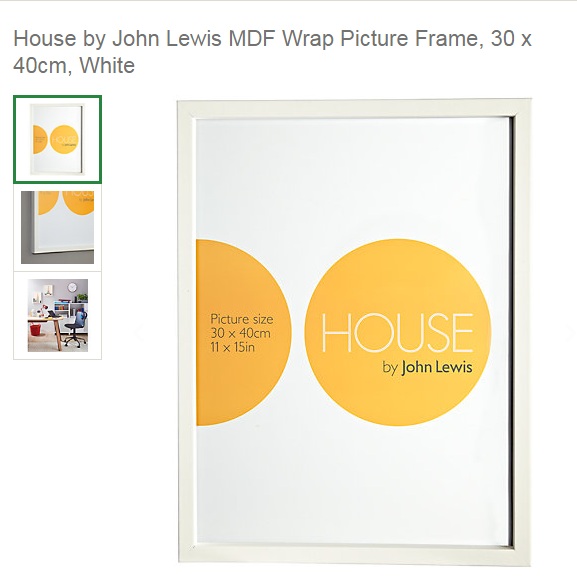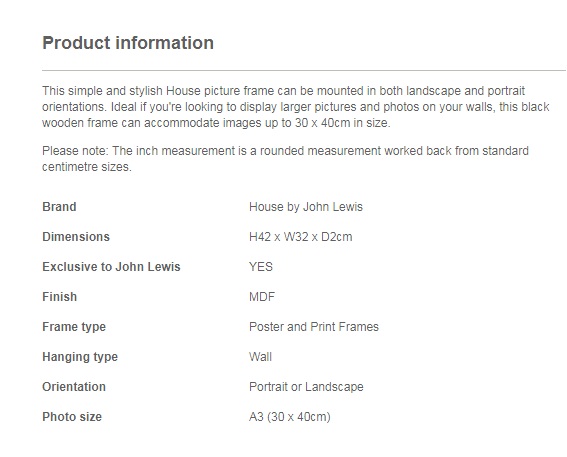How to choose a picture frame is a hot topic and I frequently receive advice-seeking queries from my customers. Framing can have a totally transformative impact on your artwork, but it’s often a bit of an after-thought. Finding the right thing can take time and cost more than you may have initially considered. Here are a handful of dos and don’ts for buying on a budget, inspired by real questions I have received from my commission and art print clients, plus annoying and expensive mistakes I have made myself.
DO Consider your options, relevant to the cost of your artwork.
If you’ve bought an art print for under £100, it’s unlikely you would want to spend as much again on a bespoke frame. Try to think about the total investment you wish to make artwork and frame before you purchase either.
DO Be realistic
Decide whether you will be bothered to re-frame your picture if you change its position or you move house. If you are unlikely to re-frame it, choose something classic like an oak or light wood, black or white frame with a square profile.
DO Consider buying an off-the-shelf frame, but having a bespoke mount cut to order.
This can be done by your local framers or online, usually for £4 – £15, depending on size. I like I Can Frame as their customer service is brilliant and my orders have always been millimetre perfect. A coloured mount highlighting one of the colours in your artwork may look really striking and unique. I feel wide mounts are modern, luxurious and pleasing, which is why all my art prints come with a slightly-wider-than-average mount as standard.
DO recycle, repurpose, re-use.
I have successfully upcycled frames with a tester pot of paint many times. I have also bought enormous, expensive bespoke frames in clearance sales and through online auctions for the price of an IKEA standard A4 frame. It seems to be one of those items that people clear out, people who perhaps don’t have the imagination to modernise something that is old-fashioned but not antique.

It’s me in the studio with my recent haul of second-hand frames, ripe for upcycling. Total cost – £31.
DON’T mix up inches, centimetres or ‘A’ sizes.
Many retailers will list all three measurements on their packaging, eg A3 / 15 x 11 inches / 40 x 30cm. In very small print, they may then indicate that one measurement has been rounded up or down. Here is an example from my much-adored John Lewis. Please don’t get me wrong, I would live in John Lewis if I could, but the below is quite frankly baffling especially if you are stood on the shop floor without a ruler.


So to be precise, please look below at the equivalent measurements in millimetres. They are not the same, as retailers may have you believe.
A3 420mm x 297mm
15 inch x 11 inch 406mm x 279mm
40cm x 30cm 400mm x 300mm
I have learned (the expensive way) that even if your artwork or mount are a few millimetres too big for the frame, it’s never going to fit. Trimming it carefully requires a knife, metal ruler and a cutting board – or a trip to the framers which is a hassle for such a small adjustment. I trawled the high street, and decided that most brands ultimately use centimetres, even if they list the other units of measurement too.
DON’T forget to protect your artwork.
Magnetic hangers are new, trendy, quick, cheap, convenient, easy to assemble and easy to change. They are great. BUT please never hang a piece of artwork unprotected by UV glass in direct sunlight. You’d be amazed – and hugely disappointed – by how quickly the sun will damage your artwork. Surprisingly, it’s the paper that will yellow, years before ink will fade. This applies for all different kinds of paper, and the damage is irreparable.
Essentially, a quality local framer is always going to produce the optimum results for you. They will consult on types of frames, the many types of glass and acrylic, offer acid-free backing, conservation tapes, fit your artwork perfectly and securely… But the good news is there are plenty of cheaper alternatives in department stores that can work brilliantly and it’s always a thrill to discover a second-hand treasure. Have you had any framing successes or disappointments? I’d love to hear your tips and ideas on how to choose a picture frame.
Further Reading:
Apartment Therapy has a useful visual step-by-step guide to DIY framing
Artist Network gives a more thorough breakdown of your options
Copyright Charlotte Argyrou Illustration 2019 - 2023 • Privacy Policy • Terms and Conditions • Image Credits

